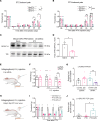Satellite glial GPR37L1 and its ligand maresin 1 regulate potassium channel signaling and pain homeostasis
- PMID: 38530364
- PMCID: PMC11060744
- DOI: 10.1172/JCI173537
Satellite glial GPR37L1 and its ligand maresin 1 regulate potassium channel signaling and pain homeostasis
Abstract
G protein-coupled receptor 37-like 1 (GPR37L1) is an orphan GPCR with largely unknown functions. Here, we report that Gpr37l1/GRP37L1 ranks among the most highly expressed GPCR transcripts in mouse and human dorsal root ganglia (DRGs) and is selectively expressed in satellite glial cells (SGCs). Peripheral neuropathy induced by streptozotoxin (STZ) and paclitaxel (PTX) led to reduced GPR37L1 expression on the plasma membrane in mouse and human DRGs. Transgenic mice with Gpr37l1 deficiency exhibited impaired resolution of neuropathic pain symptoms following PTX- and STZ-induced pain, whereas overexpression of Gpr37l1 in mouse DRGs reversed pain. GPR37L1 is coexpressed with potassium channels, including KCNJ10 (Kir4.1) in mouse SGCs and both KCNJ3 (Kir3.1) and KCNJ10 in human SGCs. GPR37L1 regulates the surface expression and function of the potassium channels. Notably, the proresolving lipid mediator maresin 1 (MaR1) serves as a ligand of GPR37L1 and enhances KCNJ10- or KCNJ3-mediated potassium influx in SGCs through GPR37L1. Chemotherapy suppressed KCNJ10 expression and function in SGCs, which MaR1 rescued through GPR37L1. Finally, genetic analysis revealed that the GPR37L1-E296K variant increased chronic pain risk by destabilizing the protein and impairing the protein's function. Thus, GPR37L1 in SGCs offers a therapeutic target for the protection of neuropathy and chronic pain.
Keywords: G protein–coupled receptors; Homeostasis; Neurological disorders; Neuroscience.
Conflict of interest statement
Figures








Update of
-
Satellite glial GPR37L1 regulates maresin and potassium channel signaling for pain control.bioRxiv [Preprint]. 2023 Dec 5:2023.12.03.569787. doi: 10.1101/2023.12.03.569787. bioRxiv. 2023. Update in: J Clin Invest. 2024 Mar 26;134(9):e173537. doi: 10.1172/JCI173537. PMID: 38106084 Free PMC article. Updated. Preprint.

